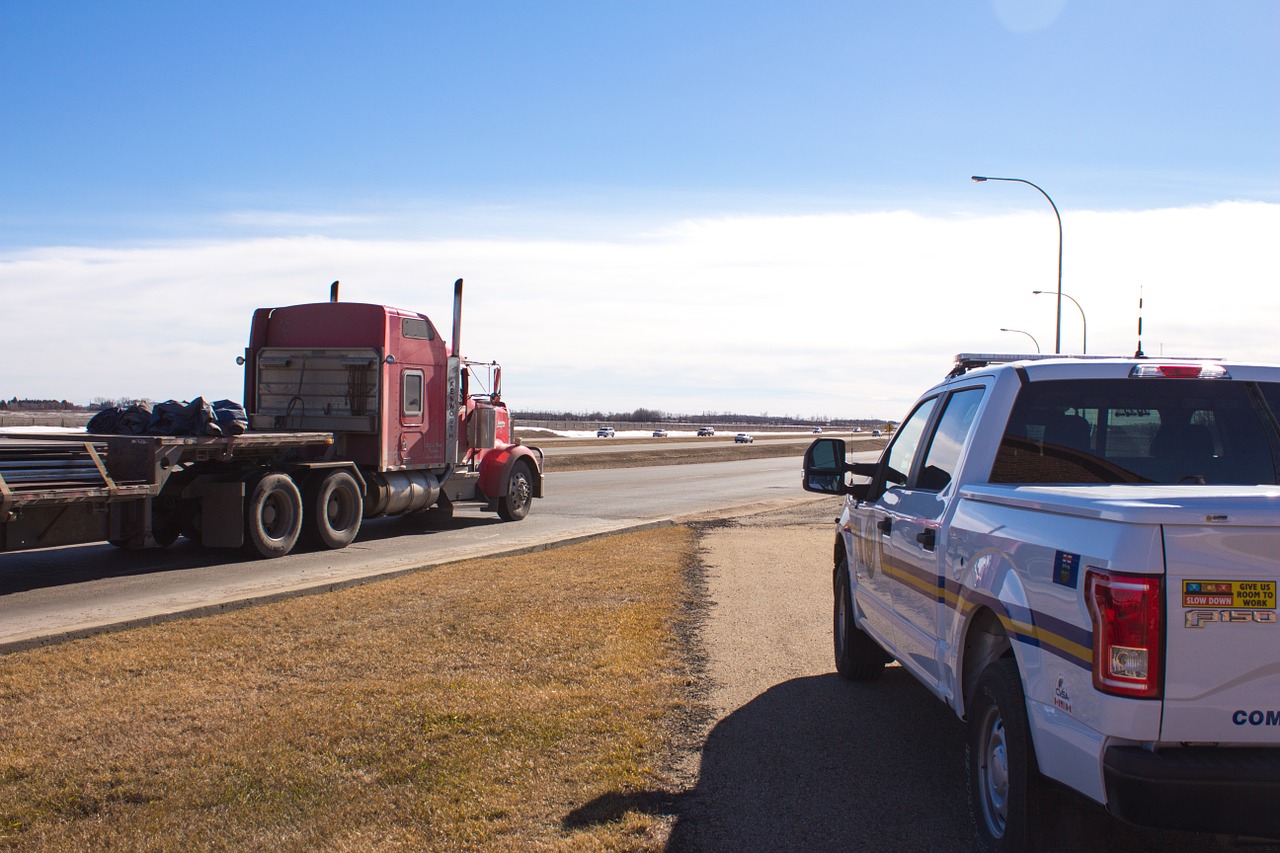Simplify Your Oversize/Overweight Loads
- Instantly Determine Permit & Escort Costs
- Calculate Max Legal/Permitted Axle Weights
- Understand Equipment Limits
Truck weight limits, DOT heavy haul regulations and overweight permits
Why weight limits exist
There are a few reasons that trucks have weight limitations on roads and need to be properly weighed. The primary reason is that the damage to the road surface does not scale linearly with the increased weight of the vehicle. A 5 ton axle does not do 5 times as much damage to the road surface as a 1 ton axle, 5 ton axle apllies 625 times as much pressure on the road surface as a 1 ton axle.
An argument can be made those heavier trucks pose increased safety risks on public highways. Weight affects the ability to maneuver the truck at highway speeds and its ability to stop. The fact is the government spends 100’s of billions of dollars every year maintaining and building road ways and weight limitations are set primarily to limit road damage to the national highway system by over-weight vehicles.
Even though weight limits exist, they are not uniform across the United States. All states must allow trucks up to 80,000 pounds on designated Federal highways if they can pass the Federal Bridge Formula test (see Federal Bridge Formula Calculator) Many states allow heavier loads without requiring special Permits.
Why this matters to you.

Since the government spends so much money on developing and maintaining roads it established hefty overweight fines and penalties for those who willingly or unwillingly break the rules they have established. This could mean up to 10’s of thousands of dollars in fines, marks on your driving record, lost of your commercial driving license or potentially even jail time. You have to be aware of the rules established by each municipality. That means Federal, State, and even city or county rules.
Truck Weight Limits
Truck manufacturers design trucks to be able to carry specific loads. In most cases, the structural integrity of the truck is designed to carry at least the heaviest load that would be permissible by maximum loaded axle weights for the roads to be traveled. The fact is many trucks are capable of carrying significantly heavier loads than would be legally permissible. Therefore, manufacturers build some trucks to haul the maximum permissible loads under any set of circumstances, i.e., a truck may be rated for a maximum gross vehicle weight well in excess of 80,000 lb. In that case, it is the responsibility of the operator of the vehicle to be aware of the highway and non highway limits for the route of travel, and not exceed the established legal or maximum permitted able gross vehicle or axle group weights for the roads on which the vehicle is to be operated.
Note: Although the maximum legal truck weight for Federal Highways is 80,000 lb., specific maximum allowable axle weights for single, tandem, and other axle arrangements vary, sometime significantly, from one state to the next. You can find the maximum allowed weight specific to your set up here Max axle weight calculator
DOT Weight Limits
Overall Limits
Overall limits are calculated from 5 different variables (all of which can vary by state) Tire width, number of tires, axle spacings, axle groups, and manufactures rating . The states will take the lesser limit of all the variables to determine your overall limits.
Axle limits
Axle and axle group weight limits vary by state, see our axle weight calculator page for more information.
Federal Bridge Formula
The Federal Bridge Formula establishes the maximum weight any set of axles may legally carry on the Interstate roadways. The FBF is a mathematical formula used to determine the appropriate weight of loads based on axle configuration (number of axles, axle spacing, weight distribution).
The formula is:

Where:
• W = the maximum weight in pounds that can be carried on a group of two or more axles to the nearest 500 pounds (230 kg).
• L = spacing in feet between the outer axles of any two or more consecutive axles.
• N = number of axles being considered.
This formula can look intimidating and because of that, Oversize.io has developed a calculator to determine whether your load meets FBF guidelines. (See: Federal Bridge Formula Calculator).
Bridge Review & Bridge Law
When axle groups or GVW (gross vehicle weights) cross a certain weight bridge reviews are required. Sometimes states like Texas require a 3rd party company to do the research other states like Oklahoma do them in house. Either way these bridge reviews are done to determine the route and the maximum allowable weights for safe travel. If the equipment fails the bridge reviews then additional equipment with more axles(groups) would be required to start the process all over again.
Note: Each state requires bridge reviews at different weight levels and also handles the reviews in different manners. Some 3rd party reviews could cost 1000’s and even 10’s of thousands of dollars depending on the route and the weight of the load being shipped.
Frost Laws
What are Frost Laws?
Oversize.IO Frost Laws by State
To strike a balance between protecting roadways during the spring thaw and allowing trucking operators to maximize their loads, northern US states and Canadian provinces have engaged in the application of "Frost Laws." Frost laws are seasonal restrictions on traffic weight limits and speeds on roadways subject to thaw weakening. During the spring thaw, the roadbed is softened by moisture trapped beneath the pavement, reducing the supporting strength of the road to less than the original construction strengths.
Note: The condition of the road surface—moisture or frost on the roadway—does not affect roadway strength (it may affect traction and controllability).
In general, during the spring thaw, maximum axle weights and gross vehicle weights will be reduced as much as 35%. Each state or province has established maximum axle and gross vehicle weights for key national and state trucking routes.
Managing Frost Laws?
"Seasonal weight restrictions" typically start in early March and continue through mid-June. Since conditions vary from year to year, from below-normal to above-normal temperatures, most states and provinces reserve the authority to adjust spring load restrictions based on observed seasonal rain and temperature conditions, weather forecasts, as well as soil moisture sampling, to determine the dates for setting and removing weight restrictions.
Weight restrictions remain in effect until sufficient moisture has escaped and the roadbeds regain stability. The most significant pavement damage occurs during the first four weeks after the onset of spring thaw.
North Dakota uses temperature probes in the base layers of pavement sections, long range temperature forecasts, and sensors in the pavement to evaluate the strength of roadway bases to forecast when load restrictions should be imposed or removed.
States may be deliberately vague about actual weight restrictions, preferring case-by-case decisions and limitations. Information may only be available by contacting the states highway department. For example, the following table, from North Dakota, appears to be typical of the weight restrictions issued in many states. The axle weights are determined by actual conditions of temperature, moisture content in the soil, and observed road conditions. Note that different weight limits may be in effect in different parts of the state.

North Dakota's Frost Law Restrictions
Operators and Frost Laws?
A review of state departments of transportation indicates 16 states have seasonal load restrictions. In many states, seasonal weight restrictions are managed by local governments or jurisdictions. Most Canadian provinces also have established spring thaw speed and weight laws.
Unlike most operating rules that, once established, may be in effect for years, even decades, Frost Laws frequently vary from year-to-year and state-to-state and operators must be aware of conditions and current road restrictions. Initial weights for both winter weights and spring thaw weight dates are subject to change based on current road conditions. Always check the state’s or province's website or the appropriate department of transportation for the latest information.
For more information visit Frost Laws By State
Heavy Haul Regulations

Heavy haul (maximum weights) trucking regulations are determined individually by each state or province. The Federal government does not issue permits or regulate heavy haul or overweight shipments. Each individual state is required to maintain its own set of state regulations.
States are tasked with issuing overweight load permits. An important element of these permits is that bridge reviews may be required to ensure that bridges are adequately rated for overweight loads.
Note, there is no requirement for heavy load sign such as a “Heavy” or “Overweight” banner on trucks operating under an “overweight” permit.
Overweight permits
Overweight permits are issued by the states. Rates vary by state and by the actual excess weight. For example, in Tennessee, an excess weight permit costs $20 plus 6 cents per ton-mile. Each state has its own set of heavy vehicle load limits and fee schedules.
Depending on the actual weight of loads, travel may be restricted to specific days of the week and/or times during the day to avoid periods of typically heavy traffic. Generally, travel times for overweight vehicles are less restrictive; still, it is important to check state and local regulations for movement of overweight loads.
Permits for Overweight Loads
Despite state differences regarding the exact limits of various weights of loads, one thing that is true across all 50 states is that a permit is required to hit the road. Even if your truck meets legal requirements, if the load is too heavy, you’ll be required to obtain a permit. Plus, you may have to obtain permit for each state your freight will travel through.
Trucking Laws and Fines
In most states, operating an overloaded truck is categorized as a misdemeanor. Several states, including Massachusetts and New York, do not classify violations of overweight operations as a criminal offense. They do, however, impose hefty civil fines.

The Cost of a Fine
A quick scan of the “Fines” tables shows the amount of a fine for different weights more than the legal gross weight of the vehicle varies significantly from state to state. For example, the table for California shows that if the actual weight is up to 1,000 pounds over the maximum legal gross weight, there will be a fine of $20. In fact, that $20-dollar ticket will probably cost closer to $175.00 after the state adds all the various “penalty assessments” (PAs) and “court costs.” If the load happens to be between 4,000 and 5,000 pounds over gross weight, the fine is listed as $175, but after all the PAs and costs are added it may total $753. (California Uniform Bail and Penalty Schedules, 2012, page 72)
While not all states add as many costs as California, almost all states add some level of “court costs” and fees that are likely to at least double the cost of the fine.
Overweight Fines
There is no uniform structure or amount for overweight fines. Many states use a sliding scale of fines. Fines for lower overweight conditions, for example, only 1000, 2000, etc., pounds overweight increase gradually with each increase of 1,000 pounds. As the excessive weight increases, the relative amount of the fine also increases. Once the load is determined to be 10,000 or more pounds over the legal gross weight, fines increase dramatically, often to several thousand dollars.
More About Fines
Many overweight situations involve two different fines. In addition to the overweight fines described above, there often is an operator fine. This is a fine levied against the driver and/or the operator (the owner or business that operates the truck). These fines may be relatively small for a first offense, from a low of $25 to $150 for the first offense. Second offenses, in the same year (two years in some states) may be twice that of the first offense. Subsequent offenses tend to be significantly higher and can include jail time, loss of vehicle registration for several months, or suspension of the operator’s commercial license. Note that “court costs” are also added to these fines.
Violations
Tractor Trailers with a maximum operating weight of 80,000 pounds represent: (1) a significant investment in the vehicle by the owner/owning company, (2) an essential, valued service to those who hire the trucks to haul their goods and equipment, (3) jobs to those who service and fuel the trucks, (4) family-supporting salaries for the drivers, (5) a significant source of tax revenue to states and communities, (6) a critical national service moving goods around the country, and (7) a potential threat to every other driver on the highways.
Speeding, over-weight loads, failure to adhere to required maximum driving and “down” times, are all factors that affect the safety of trucking operations and safety on the highways, and enforcement efforts have increased.
Background of where truck weight limits came from
The “modern era” of Federal involvement in commercial motor vehicle weight dates back to the Eisenhower Administration and the enactment of the Federal-Aid Highway Act of 1956 (Public Law 84-627), that authorized the Interstate System. That Act established weight limits to protect the Federal investment in the Interstate System from excessive damage caused by overweight commercial vehicles.”1
Specifically, the 1956 law established maximum load limits including a maximum width of 96 inches, a single-axle weight of 18,000 pounds, a tandem axle wight of 32,000 pounds, and a maximum gross vehicle weight (GVW) of 73,280 pounds.
To ensure that states followed the mandated weights, the Federal Government would withhold federal funds from non-compliant states. The 1956 act, however, under a grandfather clause, allowed states to retain established higher GVW limits within their states.
Nearly 20 years later the Federal-Aid Highway Amendments of 1974, Public Law 93-643, , increased the Federal axle weight limits to the maximum allowed today—20,000 and 34,000 pounds for single- and tandem-axles, respectively, with a GVW of 80,000 pounds. Note that the Federal limits were maximums only, and several states continued to enforce GVWs that were less than these Federal maximums.
The Surface Transportation Assistance Act of 1982 expanded the Federal maximum weight limits to Federal highways in all states. The Act also expanded Federal regulations on commercial vehicle size and required the Federal Highway Administration (FHWA) to designate a National Network of highways, including Interstates, where states were required to allow the Federal limits on weights and certain dimensions.
Size and weight changes in the 1982 Act were accompanied by changes in Federal truck taxes to better reflect the cost responsibility of heavy trucks. In addition to the tax on diesel fuel, there is a 12 percent excise tax on new truck and trailer sales, a tax on truck tires, and a heavy vehicle use tax that varies according to truck weight. Except for the diesel fuel tax, rates for other truck taxes generally have not changed since 1982.
Federal law allows all States to issue permits for overweight loads that are non-divisible. Federal regulations define “non-divisible” as any load or vehicle exceeding applicable length or weight limits which, if separated into smaller loads or vehicles, would compromise its intended use, destroy its value, or require more than eight work hours to dismantle. Some States also have authority to issue permits for overweight divisible loads, pursuant to their 1956 grandfather rights. The FHWA monitors State permitting programs for consistency with Federal permitting privileges.
